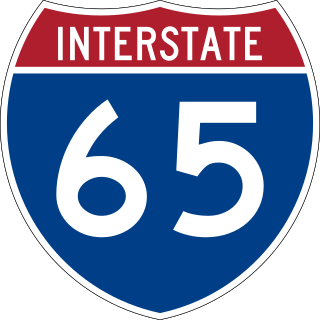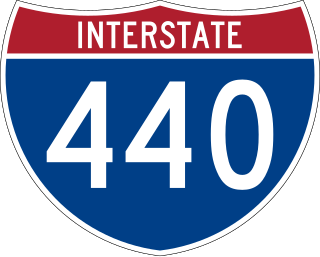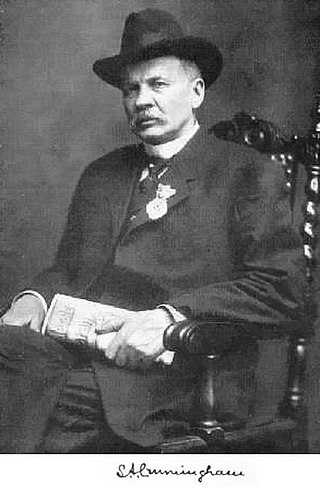
Nashville is the capital and most populous city in the U.S. state of Tennessee and the county seat of Davidson County. Located in Middle Tennessee, it had a population of 689,447 at the 2020 U.S. census. Nashville is the 21st most populous city in the United States, and the fourth most populous city in the southeastern U.S. Located on the Cumberland River, the city is the center of the Nashville metropolitan area, and is one of the fastest growing in the nation.

Interstate 24 (I-24) is an Interstate Highway in the Midwestern and Southeastern United States. It runs diagonally from I-57, 10 miles (16 km) south of Marion, Illinois, to Chattanooga, Tennessee, at I-75. It travels through Illinois, Kentucky, Tennessee, and Georgia. As an even-numbered Interstate, it is signed as an east–west route, though the route follows a more southeast–northwest routing, passing through Nashville, Tennessee. The numbering deviates from the standard Interstate Highway System grid, lying further north than its number would indicate west of Nashville. The short segment within Georgia bears the unsigned designation State Route 409 (SR 409).

Interstate 65 (I-65) is a major north–south Interstate Highway in the central United States. As with most primary Interstates ending in 5, it is a major crosscountry, north–south route, connecting between the Great Lakes and the Gulf of Mexico. Its southern terminus is located at an interchange with I-10 in Mobile, Alabama, and its northern terminus is at an interchange with US 12 (US 12), and US 20 in Gary, Indiana, just southeast of Chicago. I-65 connects several major metropolitan areas in the Midwest and Southern US. It connects the four largest cities in Alabama: Mobile, Montgomery, Birmingham, and Huntsville. It also serves as one of the main north–south routes through Nashville, Tennessee; Louisville, Kentucky; and Indianapolis, Indiana, each a major metropolitan area in its respective state.

Bicentennial Capitol Mall State Park, commonly known as Bicentennial Mall, is an urban linear landscaped state park in downtown Nashville, Tennessee. The park is located on 19 acres (77,000 m2) north-northwest of the Tennessee State Capitol, and highlights the state's history, geography, culture, and musical heritage. Receiving more than 2.5 million visitors annually, it is the most visited of Tennessee's 56 state parks.

Mount Olivet Cemetery is a 206-acre (83 ha) cemetery located in Nashville, Tennessee. It is located approximately two miles East of downtown Nashville, and adjacent to the Catholic Calvary Cemetery. It is open to the public during daylight hours.

The John Seigenthaler Pedestrian Bridge is a truss bridge that spans the Cumberland River in Nashville, Tennessee, United States. The bridge spans 3,150 feet (960 m) and is one of the longest pedestrian bridges in the world.

Interstate 440 (I-440) is an east–west auxiliary Interstate Highway that runs through Nashville, Tennessee. It serves as a southern bypass around downtown Nashville, and is located on average about three miles (4.8 km) from the center of the city. I-440 is also known locally as the Four-Forty Parkway, and is designated as the Debra K. Johnson Memorial Parkway. At a length of 7.64 miles (12.30 km), I-440 runs between I-40 and I-24, and connects to I-65 and multiple U.S. Routes. Combined, I-440 and Briley Parkway, a controlled-access segment of State Route 155 (SR 155), form a noncontiguous inner beltway around downtown Nashville.

Interstate 155 (I-155) is an east–west auxiliary route of Interstate 55 (I-55) that runs through the Bootheel of Missouri and the northwestern corner of Tennessee. It begins south of Hayti, Missouri at I-55, passes eastward through Caruthersville, and crosses the Mississippi River on the Caruthersville Bridge into Tennessee. The route then proceeds to Dyersburg, Tennessee, where it terminates at U.S. Route 51 (US 51). I-155 is the only road that directly connects Missouri and Tennessee, and is concurrent with US 412 for its entire length.

Riverfront station is a train station in Nashville, Tennessee, serving the WeGo Star commuter rail service. Located at 108 1st Avenue South in Downtown Nashville near the John Seigenthaler Pedestrian Bridge, it serves as the western terminus for the line. No parking facilities are available at the station, however, connecting bus service is provided via MTA buses. It is within walking distance of Nissan Stadium via the previously mentioned John Seigenthaler Pedestrian Bridge.

Interstate 40 (I-40) is part of the Interstate Highway System that runs 2,556.61 miles (4,114.46 km) from Barstow, California, to Wilmington, North Carolina. The highway crosses Tennessee from west to east, from the Mississippi River at the Arkansas border to the Blue Ridge Mountains at the North Carolina border. At 455.28 miles (732.70 km), the Tennessee segment of I-40 is the longest of the eight states through which it passes and the state's longest Interstate Highway.

Interstate 65 (I-65) is part of the Interstate Highway System that runs 887.30 miles (1,427.97 km) north–south from Mobile, Alabama, to Gary, Indiana. In Tennessee, I-65 traverses the middle portion of the state, running from Ardmore at the Alabama border to the Kentucky border near Portland. The route serves the state capital and largest city of Nashville, along with many of its suburbs. Outside of urban areas, the Interstate bypasses most cities and towns that it serves, instead providing access via state and U.S. Highways. The Interstate passes through the Highland Rim and Nashville Basin physiographic regions of Tennessee, and is often used as the dividing line between the eastern and western portions of the former.

John Lawrence Seigenthaler was an American journalist, writer, and political figure. He was known as a prominent defender of First Amendment rights.

State Route 386 (SR 386) is a major east–west state route, signed north-south, located in Davidson and Sumner counties in Tennessee. It is known as Vietnam Veterans Boulevard and serves as a bypass for U.S. Highway 31E and a connector to Hendersonville and Gallatin from Nashville. A majority of the route is a four-lane controlled-access highway.

Sumner Archibald Cunningham was an American Confederate soldier and journalist. He was the editor of a short lived Confederate magazine called "Our Day" (1883-1884) published in New York. In 1893 he established the Confederate Veteran, a bimonthly magazine about veterans of the Confederate States Army until his death in 1913. He was a critic of Reconstruction, "scalawags", "carpetbaggers", and "Negro" legislators.

Memorial Hall is a historic building on the Peabody College campus of Vanderbilt University in Nashville, Tennessee. It was built in 1935 as a dormitory hall for female descendants of Confederate States Army veterans. Its former name resulted in multiple lawsuits and student unrest. In August 2016, Vanderbilt announced it would reimburse the United Daughters of the Confederacy for their financial contribution and remove the word Confederate from the building.

Major Eugene Castner Lewis was an American engineer and businessman. He served as the chairman of the Nashville, Chattanooga and St. Louis Railway from 1900 to 1917. As a civic leader, he helped develop Shelby Park and Centennial Park, including the Parthenon, as well as Union Station.
Colonel Edmund William Cole was an American Confederate veteran and businessman. He was the president of the Nashville, Chattanooga and St. Louis Railway, and the founder of the American National Bank.
Ephraim Grizzard and Henry Grizzard were African-American brothers who were lynched in Middle Tennessee in April 1892 as suspects in the assaults on two white sisters. Henry Grizzard was hanged by a white mob on April 24 near the house of the young women in Goodlettsville, Tennessee.
Samuel Smith was a 15-year-old African-American youth who was lynched by a white mob, hanged and shot in Nolensville, Tennessee, on December 15, 1924. No one was ever convicted of the lynching.

The Music City Grand Prix, known as the Big Machine Music City Grand Prix for sponsorship reasons, is an IndyCar Series race held at the Nashville Street Circuit in Nashville, Tennessee. The race's most notable feature is its 3,578 ft (1,091 m) straightaway across the Korean War Veterans Memorial Bridge, which spans the Cumberland River. The bridge layout makes the track the only one on the IndyCar circuit and one of the few in the world to cross a significant body of water. Marcus Ericsson won the inaugural event in 2021. The Grand Prix is set to host the season finale from 2024 onwards.


















